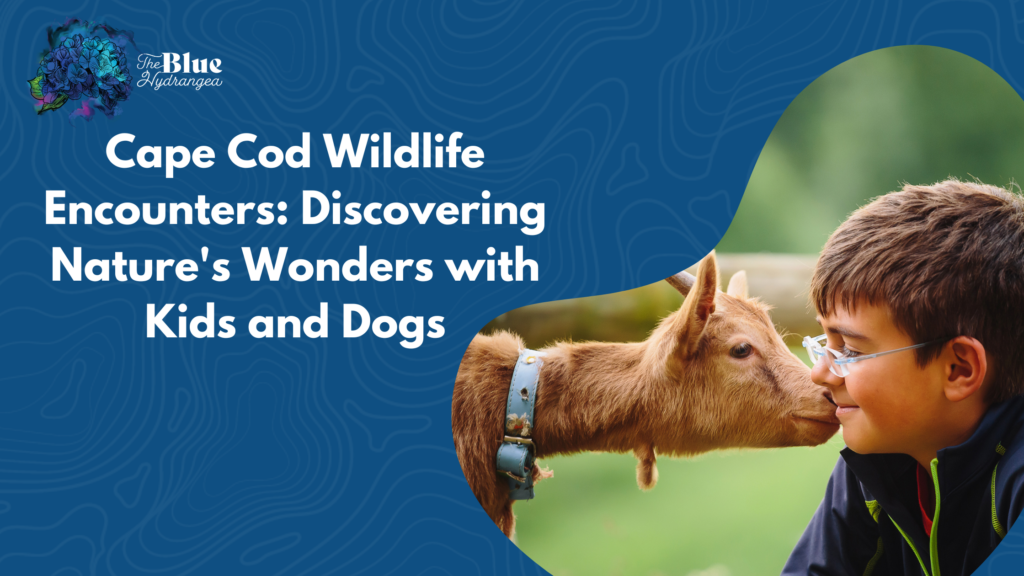Explore the natural wonders of Cape Cod and its diverse wildlife, a perfect adventure for families staying at The Blue Hydrangea.
Cape Cod’s unique geography, a blend of coastal and woodland environments, makes it a haven for diverse wildlife. Its status as a migration route adds to its rich birdlife, offering unique birding and nature adventure opportunities.
To visitors, Cape Cod offers a delightful surprise with its everyday wildlife encounters. From turkeys casually crossing the streets to the rare story of a bear swimming across the Cape Cod Canal, the region presents unique experiences. While the wildlife may not be as exotic as in other regions, the diverse ecosystems of Cape Cod – encompassing woodlands, grasslands, and marshes – nurture a variety of species. Expect to see native Massachusetts wildlife such as squirrels, foxes, rabbits, and deer, along with other interesting animals during your stay.
Common Wildlife Sightings
Cape Cod is home to a variety of mammals, birds, and marine life. From playful seals to the elusive fox, families can enjoy spotting these creatures in their natural habitats.
The most common wildlife sightings on Cape Cod include a variety of animals that make this region a fascinating place for nature lovers. Here are some of the animals you might encounter during your stay:
- Turkeys: These birds are commonly found in woodlands, lawns, and occasionally crossing roads.Once extinct in the area, turkeys have been successfully reintroduced and are now commonly seen in woodlands and crossing roads. The turkey population on Cape Cod has flourished since their reintroduction in 1995.
- Foxes: Both Red and Grey Foxes are found in Massachusetts. They are often spotted in daylight hours, especially in late spring and early summer. These omnivores frequent marshes and forested areas and are known for their playful nature.
- Deer: Deer are prevalent across Cape Cod, with a population density ranging from 6-12 deer per square mile. They are mainly threatened by coyotes and vehicles.
- Bats: There are eight species of bats found on Cape Cod. These nocturnal creatures are primarily insectivores and use echolocation to navigate and find their prey. The Big Brown Bat is the most common species in the area.
- Raccoons: These animals are abundant on Cape Cod and are adaptable to various environments. They are crepuscular and nocturnal, often seen around dawn, dusk, and night.
- Fishers: Also known as Fisher Cats, these are the second-largest weasels in Massachusetts and are natural predators of porcupines. They are mostly carnivorous and prefer to avoid human settlements.
- Coyotes: The coyote population in Massachusetts has stabilized, with sightings peaking during certain times of the year when younger coyotes are dispersing to find their own territory.
These wildlife species contribute to the unique natural environment of Cape Cod, offering visitors an opportunity to observe and appreciate a variety of animals in their natural habitats. For more detailed information about the wildlife you can encounter on Cape Cod, you can visit the Cape Cod National Seashore and Cape Cod Explores.
Less Common Wildlife Sightings on Cape Cod
While the following animals are less common, they add to the unique wildlife tapestry of Cape Cod:
- Wood Duck: Known for their iridescent purple and green heads, these ducks are unique for their tree-breeding habits.
- Osprey: Migratory birds arriving in spring from South and Central America, they are a thrilling sight for birdwatchers.
- Snowy Owl: These rare winter visitors prefer the Cape’s open beaches and sand dunes.
- Seals: While Gray seals are most common, Harbor and Harp seals also visit the Cape. Remember, where there are seals, sharks may follow.
- Whales: Endangered North Atlantic Right Whales visit in late winter and early spring. Summer brings a variety of whales to the surrounding ocean.
- Piping Plover: An endangered species, these shorebirds are a delicate part of the Cape’s ecosystem.
- Great White Shark: Increased sightings in recent years have made shark watching an unexpected attraction.
- North American River Otter: Playful and charming, these creatures are a delight to spot in the Cape’s freshwater bodies.
- Horseshoe Crab: Common in shallower sea areas, their molts are often found on beaches.
- Spadefoot Toad: A rare sighting, these toads spend much of their time underground.
- Spring Peeper: Known for their loud, high-pitched calls in spring, these frogs are a familiar sound across Massachusetts.
These less common sightings make wildlife watching on Cape Cod an exciting and unpredictable adventure.
Seasonal Wildlife Changes
Each season brings different wildlife to Cape Cod. Winter, for instance, is a great time to see certain birds and marine animals that are not present during other times of the year.
Visitors to Cape Cod can experience a variety of wildlife changes depending on the season. In the winter, you can expect to see seasonal migrants such as the dark-eyed junco, surf scoter, red-throated loon, and snowy owls. Prime locations for winter birding include Scusset State Reservation, Corporation Beach, and Chatham’s Monomoy National Wildlife Refuge.
The Cape Cod National Seashore, encompassing a diverse range of ecosystems, is home to over 450 species of animals, including amphibians, reptiles, fish, birds, mammals, and invertebrates. The park provides habitat year-round for some species, while others only during specific times like nesting season, migration, or winter.
Throughout the year, Cape Cod also witnesses remarkable bird sightings, including rare and out-of-range species. Recent sightings have included a variety of unique birds such as the Yellow-throated Warbler, Western Kingbird, Lark Sparrow, Eastern Phoebe, Ash-throated Flycatcher, Rufous Hummingbird, and many more, particularly around well-known birding spots like the Salt Pond Visitor’s Center in Eastham.
For detailed and up-to-date information about wildlife sightings and seasonal changes, you can visit the Cape Cod National Seashore and Mass Audubon’s Cape Cod Weekly Bird Sightings pages. These resources provide valuable insights into the wildlife you can expect to see during your visit to Cape Cod.
Nature Trails and Walks
The Cape offers numerous trails perfect for wildlife viewing. The National Park Service provides a comprehensive guide to these trails, suitable for all ages and skill levels.
Cape Cod offers a variety of nature trails and walks that provide opportunities to see diverse wildlife. Here are some popular trails and the wildlife you might encounter on them:
- Great Island Trail: Located in Wellfleet, this trail takes you through marshlands, dunes, dense forests, and sandy beaches. It’s a great place to spot local birdlife and enjoy the scenic views of Cape Cod Bay.
- Atlantic White Cedar Swamp Trail: This unique trail in Wellfleet takes you through an ancient forest along a wooden boardwalk above marshy swamplands. The rare Atlantic White Cedar Trees create an unusual ecosystem that supports a variety of wildlife, including birds and underwater creatures.
- Goose Pond Trail at Wellfleet Bay Wildlife Sanctuary: This easy and informative trail takes you through tidal marshlands, pine and oak forests, and to the shores of a barrier beach. It’s an excellent spot for bird watching and learning about the local ecosystem.
- Long Point Lighthouse Trail: This trail in Provincetown offers stunning ocean views and leads to Long Point Lighthouse. Along the way, you might see seals and whales near the Atlantic horizon.
- Pamet Cranberry Bog Trail: In Truro, this trail offers a mix of woodlands and panoramic coastal views. It’s a relatively easy hike and provides a glimpse into Cape Cod’s cranberry harvesting history.
- Wellfleet Bay Wildlife Sanctuary Trail System: This sanctuary in Wellfleet offers 5 miles of beautiful nature trails that overlook salt marshes and lily ponds. It’s ideal for a peaceful walk and bird watching.
- Nauset Marsh Trail: This easy trail in Eastham winds through forests and meadows, leading to Salt Pond and Salt Pond Bay, where you can enjoy tranquil waterside views.
These trails not only offer beautiful natural scenery but also opportunities to see Cape Cod’s diverse wildlife, such as various bird species, marine animals like seals, and possibly even whales. Each trail offers a unique experience, whether it’s a leisurely walk through ancient forests or an adventurous hike to a historic lighthouse.
For more information and details about these trails, you can visit New England Wanderlust’s article on Cape Cod Walking Trails and Town & Tourist’s guide on Cape Cod Hiking Trails.
Educational Opportunities
These encounters provide invaluable learning experiences for children. Organizations like the Mass Audubon offer programs that delve into the nocturnal animals of Cape Cod.
Cape Cod offers a range of educational opportunities related to wildlife and nature, perfect for families, students, and nature enthusiasts.
- Mass Audubon’s Long Pasture Wildlife Sanctuary: This sanctuary provides hands-on, inquiry-based educational experiences focused on various aspects of natural science. Programs are designed to enhance understanding of species and habitats, ecological concepts, and the interrelationship between people and nature. They offer field trips and in-classroom programs that integrate Next Generation Science Standards (NGSS) and MA Science, Technology, and Engineering Standards. These programs are suitable for all grade levels and cover a wide range of topics, from wetland ecology to climate change. For more details on their programs, you can visit the Mass Audubon website.
- Cape Cod National Seashore: The National Park Service offers unique educational opportunities for students to experience the natural and cultural treasures of Cape Cod. Their programs cover a wide array of topics, including coastal ecosystems, wildlife, cranberries, lighthouses, and cultural stories. They provide field trips, in-classroom programs, and distance learning opportunities. These programs are a great way to investigate the health of coastal ecosystems and experience the richness of Cape Cod’s history. To learn more about their educational offerings, you can visit the Cape Cod National Seashore’s education page.
These programs are excellent for enhancing one’s understanding of Cape Cod’s unique natural environment and wildlife, providing immersive and engaging educational experiences.
Addressing Safety Concerns
While enjoying wildlife, it’s crucial to do so safely. The Cape Cod National Seashore offers guidelines to ensure both your family’s and the animals’ safety.
Safety concerns for wildlife encounters on Cape Cod mainly revolve around respecting the natural habitats of the animals and understanding the risks associated with certain species.
- Great White Sharks: These sharks are present in the waters of Cape Cod, particularly where seals, their major prey, are abundant. Visitors should be cautious and aware of their surroundings when swimming or engaging in water activities. Key safety measures include swimming in groups, avoiding swimming at dawn and dusk, staying close to shore, and avoiding areas where seals are present. The use of the Sharktivity app can help track and report shark sightings.
- Beach and Water Safety: The Cape Cod National Seashore advises visitors to be mindful of beach and ocean safety. This includes being aware of rip tides, shore breaks, and strong undertows. Visitors should never swim alone and always pay attention to beach advisories, especially noting that white sharks remain active in the fall. Additionally, it’s important to avoid climbing on slopes and dunes, as sand collapses easily, and to dig holes no deeper than knee level.
- Wildlife in the Park: The Cape Cod National Seashore is home to over 450 species of animals, including federally protected species like the piping plover. Visitors should be aware of and respect wildlife habitats to ensure the safety and preservation of these species. This includes observing animals from a distance and not disturbing their natural behaviors.
For more detailed safety guidelines and information, you can visit the Cape Cod National Seashore’s page on Animals and Shark and Beach Safety guidelines.
While exploring the natural wonders of Cape Cod, safety is a priority, but it’s also important to emphasize the overall safety and accessibility of its trails and beaches. Cape Cod is known for its well-maintained and family-friendly environments, making it an ideal destination for nature lovers and outdoor enthusiasts.
Understanding Wildlife and Habitat Safety
- Respect for Wildlife: The Cape Cod National Seashore, home to over 450 species, asks visitors to observe wildlife from a safe distance and respect their natural habitats. This includes avoiding disturbances, especially during sensitive periods like nesting or breeding seasons.
- Habitat Preservation: Staying on designated trails and areas helps protect fragile ecosystems and ensures your safety. Avoiding dune climbing and deep sand digging is crucial for both personal safety and environmental conservation.
Water Safety and Shark Awareness
- Shark Safety: While Great White Sharks are present, especially in areas with abundant seal populations, following guidelines significantly reduces risks. Swimming in groups, staying close to shore, and using apps like Sharktivity for sightings help ensure a safe experience.
- Beach Safety: Awareness of ocean conditions, such as rip tides and shore breaks, is key. Cape Cod’s beaches are monitored for safety, with clear advisories and guidelines in place.
Statistical Perspective on Safety
- Statistically, incidents involving wildlife, including shark encounters, are extremely rare compared to the number of visitors enjoying Cape Cod each year. The likelihood of an adverse event is minimal when following safety guidelines.
- The Cape Cod National Seashore and local organizations are committed to providing a safe environment for visitors, with ongoing efforts to monitor and manage wildlife and beach safety effectively.
Cape Cod remains a very safe place to hike, explore, and enjoy the natural environment. With responsible practices and an understanding of the local guidelines, visitors can have a memorable and secure experience in one of Massachusetts’ most beautiful regions.
Respecting Cape Cod’s Natural Wonders: Safety and Preservation Tips
Visitors to Cape Cod should be aware of several concerns regarding wildlife and the natural landscape:
- Disturbance to Wildlife: Human activities can disturb wildlife, particularly during nesting or breeding seasons. For example, the piping plover, a threatened species, nests on the beaches. Visitors should avoid nesting areas and keep dogs on a leash to prevent disturbance.
- Habitat Alteration: Activities such as off-road vehicle use, trampling vegetation, and climbing dunes can damage fragile habitats. It’s important to stick to designated trails and areas to preserve the natural landscape.
- Invasive Species: Invasive plants and animals can threaten native species and ecosystems. Visitors should clean hiking boots, gear, and vehicles before and after visiting to prevent the spread of invasive species.
- Litter and Pollution: Littering not only spoils the natural beauty but can also be harmful to wildlife. Visitors should practice Leave No Trace principles, properly disposing of all trash and recycling.
- Climate Change and Sea Level Rise: These global issues affect Cape Cod’s natural landscape, leading to beach erosion, habitat loss, and changes in wildlife patterns.
- Shark Activity: Great white sharks are native to the region’s waters, primarily due to the seal population. Visitors should heed shark warnings and be cautious when swimming or engaging in water sports.
- Water Safety: Ocean currents, riptides, and other natural water conditions can pose risks. Swimmers should be aware of their surroundings and follow safety guidelines provided by local authorities.
For more detailed information on how to safely enjoy Cape Cod’s natural environment and wildlife, visitors can refer to the Cape Cod National Seashore’s guidelines on animals and beach and water safety, as well as the Cape Cod Chamber of Commerce’s shark safety information.
Unusual Nocturnal Wildlife
Cape Cod’s nocturnal wildlife offers a unique experience. From owls to bats, night-time can be the best time to witness some of Cape Cod’s more elusive creatures.
Cape Cod harbors a variety of unusual nocturnal wildlife, creating exciting opportunities for visitors to experience the unique aspects of the region’s natural environment after sunset.
- Great Horned Owls: These majestic birds are common on Cape Cod, known for their distinctive “hooting” calls at night. They are often found in wooded areas and can be heard in places like Dennis Village.
- Bats: Cape Cod is home to several species of bats, including the Big Brown Bat. These nocturnal creatures play a crucial role in controlling the insect population and can be spotted in various habitats across the Cape.
- Coyotes: Over the past few decades, coyotes have established themselves on Cape Cod. While they are typically shy and avoid human contact, their distinctive howls can often be heard during the night.
- Sea Turtles: Although not nocturnal by nature, sea turtles are a special mention due to their presence in Cape Cod waters. Species like Kemp’s Ridley, Green, Leatherback, and Loggerhead turtles are found here, particularly during the warmer months.
- Eastern Spadefoot Toads: These rare amphibians, known for their distinctive spade-like hind feet, are most active during rainy nights in spring or summer. They prefer sandy environments, making Cape Cod’s beaches a suitable habitat.
These species contribute to the rich tapestry of Cape Cod’s wildlife and offer unique experiences for those interested in exploring the region’s natural beauty after dark. For more detailed information, you can explore the insights provided by Cape Cod Wildlife Calling Guide Service and Miles with McConkey.
Cape Cod’s wildlife offers endless opportunities for adventure and learning, making it the perfect destination for families seeking a connection with nature.
Book your stay at The Blue Hydrangea for a memorable family adventure among Cape Cod’s natural wonders. Visit us at The Blue Hydrangea on Airbnb.
For further information, explore these resources:









